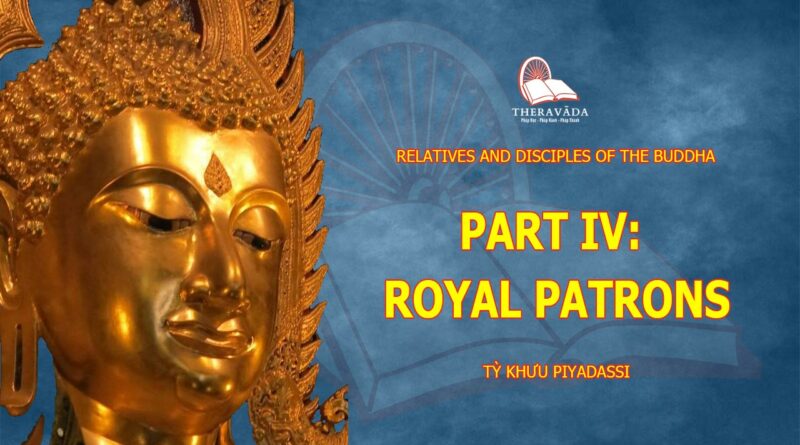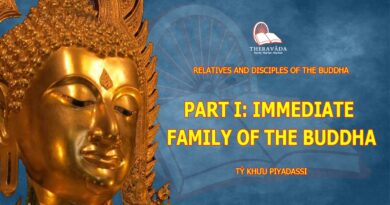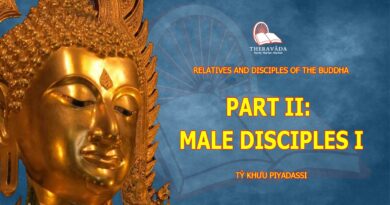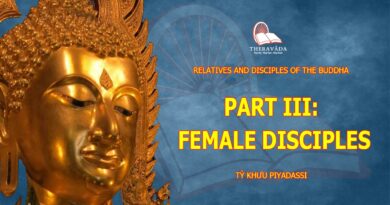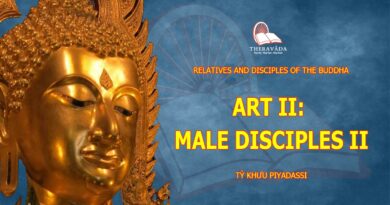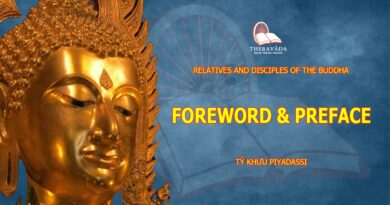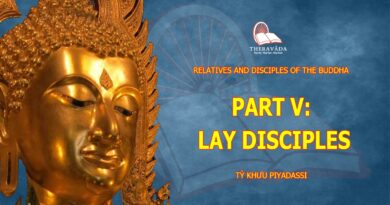Nội Dung Chính [Hiện]
RELATIVES AND DISCIPLES OF THE BUDDHA – PART IV: ROYAL PATRONS
King Bimbisara
King Bimbisara was the Buddha’s first Royal Patron. He ruled the kingdom of Magadha, the capital of which was Rajagaha, from the age of 15 when he ascended the throne until his death at the age of fifty-two.
King Bimbisara saw the Buddha for the first time prior to His enlightenment. The Ascetic Gotama was seeking alms in Rajagaha when the king saw the Great Ascetic of royal carriage and great bearing. Wishing to find out who this Great Ascetic was, the King with his royal entourage followed the Ascetic Gotama to Pandavapabbata, where He was resting after His meal. He then questioned the Ascetic Gotama on His birthplace and ancestry. Ascetic Gotama replied :
“Just straight, O King, upon the Himalayas, there is, in the district of Kosala of ancient families, a country endowed with wealth and energy. I am sprung from that family, which by clan belongs to the Solar Dynasty, by birth to the Sakyans. I crave not for pleasures of the senses. Realizing the unwholesomeness of sensual pleasures and seeing renunciation as safe, I proceeded to seek the Highest, for in that my mind rejoices.?
The King then invited the Ascetic Gotama to visit his City once He had attained enlightenment. In keeping with the promise that He had made, the Buddha visited Rajagaha after His enlightenment. Travelling from Gaya to Rajagaha, He stayed at the Suppatittha Shrine in a palm grove.
The news of the Buddha’s arrival soon spread across the city. His reputation as a great teacher and the reverence with which His Teaching was heralded, had spread to Rajagaha. The King welcomed the Buddha with a large retinue of attendants He then paid reverence to Him and sat respectfully to the side. As both the Buddha and Maha Kassapa were in attendance some of the people were not sure who was the teacher and who the pupil. Reading their minds, the Buddha questioned Kassapa as to why he had given up fire-sacrifice, a Brahmanic ritual. Recognizing the doubts in the minds of the people, Kassapa said that he had given up fire sacrifice because he preferred the passionless, peaceful state of Nibbana. Then, falling at the feet of the Buddha, he paid reverence and said, ?My Teacher, Lord, is the Exalted One – I am the disciple.”
The people were inspired by Kassapa’s devotion. The Buddha then dispensed the Maha Narada Kassapa Jataka, where in a previous birth the Bodhisatta had helped Kassapa in a similar way. On hearing the Dhamma, King Bimbisara attained the first stage of sainthood, Sotapanna. After taking refuge in the Buddha, Dhamma and Sangha, the king invited the Buddha and His retinue to the palace for their meal on the following day.
After the meal, King Bimbisara asked the Buddha what type of place would be suitable for His residence. The Buddha said that a place which was secluded and quiet, not too far but not too close to the city, would be pleasing to Him. Reflecting that his bamboo grove would be a perfect residence, the king donated the park to the Buddha and the Sangha. Even though the Buddha’s new residence was known as Veluvanarama and arama is used to denote a monastery, there were no buildings or monastery at the bamboo grove. The Buddha and His monks resided under the shelter of the trees. The Buddha spent six years of the rainy season at Veluvanarama.
After His conversion the King led the life of an exemplary monarch. He had two consorts, Kosala Devi, who was the sister of King Pasenadi Kosala, and Khema, who later became the chief female disciple of the Buddha. His Queen, Kosala Devi, gave birth to a son whom they named Ajatasattu.
Even though King Bimbisara led a righteous life he had a sad, pathetic death. Ajatasattu, led by Devadatta, attempted to kill his father to gain the throne. When King Bimbisara became aware of his son’s plan, the compassionate king handed over the throne to his son and stepped down from the monarchy. The ungrateful son, who was under Devadatta’s wicked influence, threw his father in prison with the instructions that he should be left without food, to starve to death. His mother alone had free access to the prison.
The loyal queen carried food in her waist pouch, but before long Ajatasattu became aware of his mother’s efforts. When he forbade her to carry food in her waist pouch she carried food concealed in her hair knot. When this too was discovered and forbidden she applied a mixture of honey, butter, ghee, and molasses all over her body and let the king lick her skin to sustain himself.
The cruel Ajatasattu then denied his mother access to visit the King. King Bimbisara was without any means of sustenance. But being a Sotapanna, he lived in meditative bliss and spiritual happiness. Ruthlessly, Ajatasattu ordered his barber to slash the old king’s feet and place a mixture of salt and oil on the wounds. He then commanded him to walk on hot coals. Upon seeing the barber, King Bimbisara thought that his son had realized the folly of his behaviour and was sending the court barber to help cut his hair and beard so that he could be cleaned up for release. But it was not to be. The barber started the inhumane torture as instructed by the new king. The aged King Bimbisara died in extreme agony as the result of an unwholesome action performed in a past life.
On the same day that the old king died the news was brought to Ajatasattu that his wife had given birth to a baby son. Overcome by parental joy and happiness the king asked his mother if his father too had loved him as he did this new-born babe. His mother, Kosala Devi, then informed the cruel Ajatasattu of the great love that Bimbisara had had for him.
Ajatasattu’s mother revealed that when she was carrying him there had arisen in her an inhuman desire to drink the blood from the hand of the king. She had concealed this desire but had withered away as it was a craving that she could not control. On hearing of her problem the king gladly cut open his palm to let her drink his blood.
The sages who could foretell the future had declared that this son would be an enemy of the king. The queen had then wanted to abort the baby but King Bimbisara, full of love and pride for the unborn child, had refused. Later, when the baby was born, the sages had again foretold that he would be an enemy of the king. For the second time the queen had wanted to kill the baby. For the second time the king had prevented her from killing her son. The queen had named the baby Ajatasattu, or unborn enemy.
The queen then added that on one occasion when an infected boil on the baby’s foot had made him fretful and angry she had taken him to the court to ask the king’s advice. On hearing of the problem the king had placed the baby’s foot in his mouth and sucked at the boil. The boil had then burst, spitting pus and blood into his mouth. The king, full of love and compassion, had swallowed the pus and continued to soothe the baby.
Ajatasattu was filled with shame and regret upon hearing his mother’s words. He sent a message to release his father but it was too late. King Bimbisara had closed his eyes forever, and was immediately reborn in the Catumaharajika Heaven as a god named Janavasabha. Influenced by the Dhamma, King Ajatasattu changed, and became one of the lay followers of the Buddha and the patron of the First Sangha Council.
Queen Mallika
Mallika was the beautiful and talented daughter of the foreman of garland-makers in Savatthi. Mallika, who was sixteen, often went to the public flower gardens with her friends. One beautiful, clear day she packed a lunch of special rice and set out for the flower gardens to join her friends. As she was leaving the city, she saw the Buddha with a group of monks seeking alms.
So inspired was Mallika by the serenity and presence of the Buddha that she offered Him the lunch she had packed and prostrated herself at His feet. She had no idea that she was offering her food to the Buddha but was overjoyed and suffused with happiness by her impulsive gesture.
The Buddha accepted the gift and smiled. ananda, the Buddha’s personal attendant, knowing that the Buddha would not have smiled without a reason, asked Him why he had smiled. The Buddha replied that this girl would reap the benefits of her gift the very same day by becoming the Queen of Kosala.
This seemed an impossibility for Mallika was of low caste. In India at that time the caste system flourished. It seemed very unlikely that King Pasenadi Kosala would choose a girl of low caste as his queen. King Kosala, who was one of the powerful kings of India, was at that time in battle with King Ajatasattu, the king of Magadha. Defeated in battle he was returning, downcast, when he heard sweet, melodious singing in the flower garden. Enchanted by the singing he rode into the flower garden to find the exceedingly beautiful Mallika. Mallika, who was overjoyed by her gift to the Noble One, was dancing and singing in happiness among the flowers.
For some time King Kosala observed Mallika, who was a vision of beauty and grace. Then, dismounting from his horse, he spoke to her and asked if she was married. When Mallika replied that she was not married he talked to her about his misfortune in battle. Soothed by her consoling words and enraptured by her beauty and gentleness, he decided to make her his queen. Placing her carefully on his horse he took her back to her parents’ home. In the evening he sent an entourage to fetch her to the palace and made her his queen.
As the beloved of King Kosala, Mallika was respected by all and surrounded by luxury and a multitude of servants, who fulfilled her every wish. Soon it was known to all that Mallika the flower girl was elevated to the position of Queen of Kosala resulting from the effects of her heartfelt gift to the Buddha. Wherever she went people would joyously honour her, saying, “There goes Mallika, our queen, who gives generously to the Buddha.”
Mallika in turn became a devoted follower of the Buddha and a supporter of the Noble Order. She was also an intelligent queen who questioned and analyzed her observations. Observing the different status of people, her elevation from poverty to wealth and power, and convinced that nothing happened without a cause, Mallika went to the monastery where the Buddha was residing with the following question:
“Why is it that some women are beautiful, wealthy and powerful,
While some are beautiful but without wealth and power,
And yet others ugly but wealthy and powerful,
And some ugly, poor and without power?”
The Buddha then explained to her that those who are gentle and patient are born beautiful. Those who have given generously are born wealthy. And those that who not envious and rejoice in the success of others are born with power. Rare is the person who has performed all three of these deeds and as such, depending on their actions, one found a combination of these traits in persons. Mallika then decided that she would practise generosity, compassion and patience, and be happy at the success of others.
She provided alms and requisites to the Buddha and His retinue and built an ebony hall for Dhamma discussion. She practised gentleness to her husband and servants and all others with whom she came into contact when performing her duties as queen. And when King Pasenadi Kosala decided to take a second wife, Vasabha Khattiya, she welcomed her and treated her as a younger sister without envy or jealousy.
Mallika also helped King Kosala, who was a follower of the Brahmins, to have confidence in the teachings of the Buddha. The king had had some disturbing dreams, which he felt represented some misfortune. Summoning the Brahmin priests the king asked them to interpret his dreams. Claiming that the Gods were displeased, they requested a huge animal sacrifice to appease the Gods. Mallika, who practised the Buddha’s teaching of compassion and loving-kindness to all living beings, was horrified to find preparation for the slaughter of so many animals. She advised the King to seek the Buddha’s counsel on the meaning of his dreams.
The Buddha informed the king that these dreams did not foretell any misfortune for him. As a result of his practice of meditation, the king had dreamt of the future in the matter that was closest to him, the royalty and the government. The Buddha said that these dreams signified the downfall in society that would occur as a result of moral deterioration of royalty and their governments. King Pasenadi Kosala became a devoted follower of the Buddha and a royal patron after this incident.
The king also requested the Buddha to send a teacher to the palace to instruct his wives in the Dhamma. The Buddha delegated ananda to teach Mallika and Vasaba Khattiya the Dhamma. Mallika, with her keen mind, progressed rapidly, but Vasaba Khattiya (who was a relative of the Buddha) was inattentive, slow to understand and had difficulty in grasping the Dhamma. ananda approached the Buddha and informed him of the progress of the two royal ladies by saying that Queen Mallika grasped the concepts of the Dhamma and practised diligently what he taught, but that the Buddha’s kinswoman had derived little benefit from the Dhamma. The Buddha confirmed ananda’s assessment by saying that well-spoken words were fruitless to those who did not study and practise the Dhamma, just as a beautiful flower without scent, while the well-spoken words were fruitful to those who studied and practised the Dhamma, like a beautiful flower that was laden with scent.
Even though the king and queen were a devoted couple they had their differences. In one instance the king had a falling out with Mallika regarding the way she was carrying out her royal duties. The Buddha then advised the king to reconcile their differences by relating instances from their past lives.
The first instance was when they were born as husband and wife in the Deva world. They had been very attached to each other and one day had been separated due to a flash flood that prevented the king’s return to their home. So worried and grief-stricken had they both been in their separation that they had vowed never to be separated again even for one day.
The other was when the king had been the crown prince and Mallika his consort. The prince had contacted leprosy and had decided to give up his kingdom and live in the jungle away from his subjects. The queen had decided that she would join him and had taken care of him and nursed him to health. When King Kosala heard these incidents from the past he forgave Mallika and reconciled their differences. Mallika, in gratitude to the Buddha for His counsel, said:
“With joy I heard your varied words,
Which were spoken for our welfare.
With your words you dispelled my sorrow.
May you live long, my Ascetic Bringer of Joy.”
Though Mallika led a blameless life of generosity and loving-kindness she transgressed and indulged in sexual misconduct in one instance. When questioned by the king, without owning up to her inappropriate behaviour, she lied to cover up her disgrace.
This one incident, which occurred shortly before her death, must have worked on her mind because at death she was reborn for seven days in hell.
King Kosala was grief-stricken at the death of his chief queen and visited the Buddha to find out her place of rebirth. Knowing that she was reborn in hell due to her misconduct and deceit, and not wanting to add to the sorrows of the king, the Buddha distracted the king by giving an inspiring discourse that took his mind away from the question. For six days the Buddha prevented King Kosala from asking the place of Mallika’s rebirth by distracting him with inspiring teachings. On the seventh day he informed the King that Mallika had been reborn in the Tusita Heaven among the Devas of delight.
King Pasenadi Kosala
King Pasenadi Kosala was the son of King Maha Kosala who reigned in the kingdom of Kosala, the capital of which was Savatthi. He had two consorts. His chief consort, Queen Mallika, was the daughter of a garland maker. His second consort, Vasabha Khattiya, was the daughter of Mahanama (one of prince Siddhatta’s cousins and Anuruddha’s brother) and a slave girl. He and Vasabha Khattiya had a son named Vidudhabha who, when he came of age, attempted to destroy the Sakyan race and capital.
King Kosala’s conversion from Brahmanism to the teachings of the Buddha seems to have occurred very early in the Buddha’s ministry. King Kosala had questioned the Buddha, and the Buddha had dispensed a very interesting sutta on four objects that should not be disregarded or overlooked: a warrior prince, a snake, a fire, and a Bhikkhu. The Buddha had then gone on to explain that a warrior prince, though young, may ruthlessly cause harm to others if enraged, just as would a small, poisonous snake. A little fire may produce a conflagration and even a young monk could be an Arahanth. The king had been inspired by this sermon and had taken refuge in the Buddha, the Dhamma and the Sangha. However, his Chief Queen, Mallika, a very devout follower of the Buddha, was largely responsible for his religious enthusiasm.
In the Samyutta Nikaya there are many discourses that the Buddha had dispensed for King Kosala. They have been compiled and preserved as the Kosala Samyutta. Once when the king was in the company of the Buddha, a group of ascetics with long hair, beards, and long nails had passed. The king had got up, respectfully saluted them, and introduced himself by saying that he was King Pasenadi Kosala. When they had passed he had approached the Buddha and inquired as to whether they were Arahanths or those who were striving for Arahanthship. The Buddha explained that it was difficult for ordinary persons to ascertain if a person is an Arahanth. He had then explained that it is by association that one can judge a person’s conduct, and only after a long time of association. He had then gone on to add that it is only a heedful and intelligent person who would be able to make such a distinction. His instruction is just as applicable today as there are among us many who hide impure thoughts behind a mantle of outward purity.
The Buddha said:
“Not by his outward guise is man well-known,
In fleeting glance let none place confidence.
In garb of refined, well-conducted folk
The unrestrained live in the world at large.
As a clay earing made to counterfeit,
Or a bronze halfpenny coated with gold,
Some fare at large, hidden beneath disguise,
On the surface comely and fair; within impure.”
— (Kindred Sayings 104-106)
By necessity the king was often at war to defend his kingdom. With wisdom, the Buddha consoled the defeated king and reminded him of the futility of conquest. His wisdom applies just as much today as it did over 2,500 years ago. The Buddha said:
“Victory breeds hatred,
The defeated lives in pain.
Happily the peaceful live,
Giving up victory and defeat.”
— (Dhammapada 121)
On another occasion the king was victorious in battle and confiscated King Ajatasattu’s entire army, only sparing his life. When the Buddha heard of the king’s victory He explained to him that anger breeds anger and explained the law of cause and effect (kamma) by saying:
“A man may spoil another,
Just so far as it may serve his ends,
But when he’s spoiled by others,
He, despoiled, spoils yet again.
So long as evil’s fruit is not matured,
The fool does fancy, now’s the hour, the chance!
But when the deed eventually bears fruit,
He fareth ill.
The slayer gets a slayer in his turn,
The conquered gets one who conquers him.
The abuser wins abuse,
The annoyer frets.
Thus by the evolution of the deed,
A man who spoils is spoiled again.”
The Buddha’s advice to King Kosala on his disappointment when Queen Mallika gave birth to a baby girl is history making! The Buddha advised the king that a well brought-up girl could be even better than a son and counselled him to take care of her and bring her up with love and devotion. When she grew up, Queen Mallika’s daughter, Princess Vajira, became the Queen of Magadha. No religious teacher had made such a bold statement, especially in India at a time when women were considered to be inferior to men and often treated with disrespect.
The Buddha also helped the king overcome his grief at the death of his beloved grandmother by reminding him of the impermanence of all things. King Kosala approached the Buddha and informed Him that he would give anything within his means to save his grandmother, who was like a mother to him. The Buddha consoled him by saying,
“All beings are mortal, they end with death;
They have death in prospect.
All vessels wrought by the potter,
Whether they are baked or unbaked,
Are breakable – they end broken;
They have breakage in prospect.”
Reminded of the impermanence of all phenomena King Kosala strengthened his mind and left.
Observing the generosity of the Buddha’s chief benefactor, Anathapindika, King Kosala decided to follow his example. He invited five hundred monks daily to the palace for their noonday meal. At the start he was very enthusiastic and arranged for everything with great fervour, but later, busy with state affairs, he left it to his servants to entertain the monks. After some time he was surprised to find that the monks were taking the food and giving it to other lay devotees, who in turn offered it back to the same monks. The king approached the Buddha and asked Him the reason for this strange behaviour by the monks.
The Buddha then informed King Kosala that his servants were offering the rich food in a careless manner. Often they insulted the monks and called them parasites and asked them to work and earn their own food. “The monks”, He said, “were not comfortable in accepting the food under these conditions.” The lay devotees, however, unable to afford such food to give to the monks themselves, were eager to use this opportunity and offered the food back with fervour. The Buddha then explained to the king that when persons like Anathapindika and Visakha gave to the monks they gave with great devotion and fervour, and the monks, who could sense their happiness in giving, were comfortable in accepting. They welcomed the monks and treated them as spiritual friends who lived for the welfare and benefit of all beings. He then said:
“A dish may be insipid or savoury,
The food may be meagre or abundant,
Yet if it is given by a friendly hand,
Then it becomes a delicious meal.”
–(Jataka 346)
King Kosala was a strong supporter of the Buddha and used every opportunity to listen to the Dhamma. However, despite his benign and compassionate influence, his son, Vidudhabha, was a rebel. King Kosala had an unfortunate death at the hands of his cruel and greedy son.
The king often visited the Buddha to hear the Dhamma. When he did, he was in the habit of removing his crown at the monastery gate. The king then left some of his guards at the entrance to ensure the security of his crown. Vidudhabha, who was familiar with his father’s behaviour, used this opportunity to steal the crown. Seizing the crown, he had his men kill the king’s guards. He then left a servant at the entrance to inform King Kosala that he was now the ruler and that the king was no longer welcome in the kingdom.
The king was dismayed to hear from the servant about his son’s behaviour. Since it was late in the night and starting to get cold, he walked to a neighbouring kingdom, but the city gates were closed for the night. He then walked back to Savathi hoping that his son would let him into the city, only to find the gates closed. The old king lay down in a hut outside the city gates in the extreme cold and wrapped his robe around him to keep warm. But his heart was weak. He could not tolerate the cold or the sorrow of his son’s conduct. King Kosala died in loneliness outside the city walls, in a hut, alone with one servant
Vidudhabha ruled the kingdom ruthlessly. On finding out that his mother was the daughter of a Sakyan prince and a slave girl and that his father had been tricked into marrying her, Vidudhabha was furious. Vowing to wash his hands in the blood of the Sakyans just as the chair which he had sat had been washed in milk to cleanse it of his non-Sakyan bloodline by the blue-blooded, arrogant Sakyans, Vidudhabha waged war. On his third attempt he killed the majority of the Sakyan royalty in Kapilavatthu. The remainder fled to form a new city. Vididhabha and his men in turn met their death on the banks of the river during a flash flood.
Samavati
At the time of the Buddha there lived a man and woman who had a beautiful daughter named Samavati. They lived in harmony and happiness until the plague broke out in their city. Fearing for their lives, they decided to travel to Kosambi, the capital of Vamsa, where they hoped to seek support from Ghosaka, the Finance Minister of King Udena, who was a family friend.
The municipality had set up a public alms hall to cope with the refugees left homeless as a result of the plague. Samavati went there to obtain food for her parents and herself. On the first day she asked for three portions of food, on the second day she asked for two portions of food, and on the third day she asked for one portion of food.
Mitta, the man who was distributing the food, asked her sarcastically if she had finally realized the capacity of her stomach. Samavati replied quite calmly that on the first day there were three of them for whom she was taking food. Then her father succumbed to the plague and died. On the second day she was bringing food for her mother and herself. Then her mother succumbed to the plague and died. And so, today, she only needed one portion of food.
Mitta felt badly about his sarcasm and thoughtless remark. He offered to adopt Samavati as his foster child. Samavati agreed. She then joined her foster father in helping in the distribution of alms. Before long Samavati, who was very capable and intelligent, had organized the chaotic and noisy alms hall into an orderly, well-run operation. So much so that Ghosaka, the Finance Minister, was surprised at the change and complimented Mitta on his organization. Mitta modestly gave the credit to his adopted daughter and introduced Ghosaka to Samavati.
When Ghosaka found out that Samavati was his departed friend’s daughter he decided to adopt her and bring her up as his own. Even though Mitta loved her dearly and did not want to lose his foster daughter he realized that she would have many luxuries as the Finance Minister’s daughter that he could not possibly afford. Not wanting to stand in the way of Samavati’s good fortune, he agreed. As Ghosaka’s daughter, Samavati became heiress to a large fortune and moved among the nobility.
The king of Kosambi, King Udena, had two beautiful consorts. He had married the first, Queen Vasuladatta, for political reasons, and his second queen, Magandiya, for her intelligence. Neither of his consorts, however, provided him with the love, compassion and gentleness that he wanted from a wife. In fact, if anything Magandiya was rather cold, self-centred and harsh.
One day the King saw the beautiful, gentle and compassionate Samavati. Captivated by her beauty and gentleness, he decided to have her as his third consort. Ghosaka, who loved his adopted daughter dearly and knew the temperament of the king, refused. King Udena was furious. He dismissed Ghosaka from his position as Finance Minister and confiscated his mansion.
Samavati was desolate at the misfortune that her adopted father had to face on her behalf. Even though she did not want to marry the king she agreed to his proposal providing that Ghosaka was reinstated and given back his mansion. The King agreed. Samavati soon became the King’s favourite consort.
In keeping with her position, Samavati had a large retinue of servants who took care of her every wish. Among them was a servant named Khujjuttara. Each day the queen gave Khujjuttara eight gold coins to buy flowers. Each day Khujjuttara pocketed four of the gold coins and bought flowers with the remainder. One day when she went to buy flowers the florist informed her that he had invited the Buddha and His monks for alms and asked her if she would like to stay and participate.
Khujjuttara agreed. She stayed on to help and after the meal listened attentively to the Buddha’s discourse. Khujjuttara was transformed by the Buddha’s teaching. She had a keen mind developed over countless years. By the end of the discourse she attained the first stage of sainthood, Sotapanna. Regretting her former deceit, Khujjuttara bought eight gold coins’ worth of flowers for the queen.
The moment Queen Samavati saw Khujjuttara she noticed a difference. Khujjuttara looked serene and exuded an inner radiance. She was also perplexed as to why there was double the quantity of flowers. The queen questioned Khujjuttara about her transformation and the extra flowers. Khujjuttara confessed the truth and her previous deceit and begged for forgiveness. She then informed the queen about the discourse of the Buddha that had changed her life.
Impressed by Khujjuttara’s inner transformation the queen decided to find out more about the Buddha and His teachings. She appointed Khujjuttara as her personal attendant and requested her to visit the monastery every day. She instructed her to listen to the Dhamma and come back and teach what she had learned to the queen and her court.
Khujjuttara, who had an outstanding memory, repeated the Buddha’s teaching word for word. The queen and her ladies were inspired by the Dhamma and Kujjuatara’s gift to them. Placing her on a higher chair and themselves seated on lower seats, they listened to her with respect and gratitude.
Queen Samavati, who was totally inspired by the Dhamma, asked the king’s permission to invite the Buddha and His disciples to the palace for their daily meals. Unable to attend Himself, the Buddha sent ananda as His representative to the palace. Each day (whilst the Buddha was in residence in Kosambi), ananda accepted his noonday meal from Queen Samavati and taught her and the ladies of her court the Dhamma. Before long Queen Samavati attained the first stage of sainthood, Sotapanna. Many of the ladies of the court also attained higher stages of sainthood. Her foster father, Ghosaka, embraced the doctrine and built a large monastery in Kosambi named Ghositarama for the Buddha and His retinue.
Queen Samavati continued to grow in the Dhamma. Her most outstanding trait was her immense love and compassion for all living beings. Samavati was the embodiment of compassion and loving-kindness and radiated it to all with whom she came in contact.
However, the Queen’s popularity and the fact that she was undoubtedly King Udaya’s favourite did not please Queen Magandiya. She had accepted Samavati as it was common practice for the King to have more than one consort. But she could not accept Samavati’s veneration of the Buddha and the Dhamma.
As a young girl Magandiya had been exceptionally beautiful. Her parents when looking for a suitable partner for her had looked for an exceptionally handsome and cultured man. One day the Buddha had visited their house in seek of alms. Not recognizing the Buddha, but pleased with his deportment and countenance, they had offered Magandiya in marriage to Him. The Buddha had refused the offer and dispensed a sutta on impermanence and the loathsomeness of the body for which He had no desire. Magandiya, however, who was vain and proud of her beauty, took His discourse personally and felt slighted at being refused. Seeing Samavati venerate the Buddha who she felt had slighted her made her remember the old wounds. She decided to focus her anger and jealousy on Samavati. She tried many times to break the faith and love that King Udena had for Samavati by making false accusations. But Samavati remained calm and full of compassion and loving-kindness. Nothing that Magandiya did changed the strong love that the king had for his favourite queen.
In desperation Magandiya decided to kill the queen. With the help of some greedy relatives she planned to set fire to her quarters on a day when she herself was away from the city. Magandiya was aware of the king’s wrath and wanted to ensure that no blame could possibly be directed at her. Queen Samavati and the majority of her court perished in the fire. The queen, however, remained to the end full of compassion and loving-kindness. She encouraged her ladies, who were engulfed by flames, to concentrate and abide in the Dhamma by saying:
“It would not be an easy matter,
Even with the knowledge of the Buddha,
To determine exactly the number of times
Our bodies have thus been burnt by fire
As we have passed from birth to birth
In the beginning-less round of existence.
Therefore be heedful.”
Inspired by her words the ladies of the court meditated and achieved mental development so that at death all among them had entered the various stages of sainthood.
On hearing the sad news the monks questioned the Buddha as to the place of rebirth of the queen and her ladies and the cause of their tragic death. The Buddha then informed them that all of the ladies had reached either the first, second or third stage of sainthood and as such were reborn in the Deva and Brahma Realms from which they would in due course attain Arahanthship.
He then went on to explain that in a previous birth Samavati had been born as Queen of Benares and had gone to the river to bathe with her ladies. Feeling cold, she had instructed her maids to set the bushes that surrounded them on fire. Too late they had realized that a Pacceka Buddha was meditating there, hidden from view among the bushes. Afraid that she would be admonished for her careless act if the Pacceka Buddha lived to tell His story, she had instructed her maids to pour oil over Him in the hope of killing Him. They had not succeeded in killing the Pacceka Buddha, but the premeditated murder had resulted in Samavati’s and her ladies’ present demise.
Despite Magandiya’s devious plan the king realized that she had instigated Samavati’s murder. Maddened by his grief he instructed Magandiya and her relatives to be tortured and burned to death as punishment. Later the king regretted his revenge. He kept seeing the compassionate Samavati and felt that he was even more distanced from her due to his act of revenge than resulted from her death. He embraced the teachings of the Buddha that had transformed Samavati and became one of his royal patrons. The Buddha declared Samavati to be foremost among the female lay disciples who practised loving-kindness.
Source: Budsas.net

